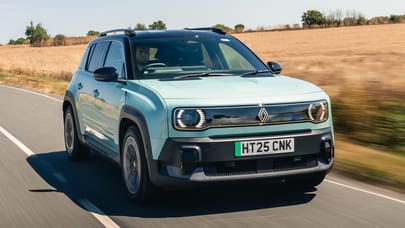
Road Test: Defender 110 Electric Prototype Auto
Few forms of propulsion can bring unexpected advantages. Land Rover was commissioned to make an electric Defender by the Londolozi Game Reserve in South Africa. It's an open vehicle sprouting eight high-mounted chairs for viewing wildlife. Electric drive makes it quiet, so as to creep up on them. You'd expect that. The unexpected but vital advantage is that if said wildlife should look upon the vehicle and its passengers as a charcuterie trolley, it can travel as fast in reverse as it can going forwards.
Land Rover has further developed the electric 110, increased the power and built seven more. It isn't going on sale. This is a science project for LR's researchers who are studying electrification and hybridisation in myriad forms across the JLR range.
I was rather hoping for individual wheel motors and electronic torque-vectoring for awesome off-road traction and control. Nope, it's all simpler than that: a single central motor driving all four wheels, with a two-ratio transfer 'box and centre diff lock for extra-sticky going.
So you can easily tiptoe your way over a scarily large obstacle. Well, it scared me. The engineers also claim, though I didn't have the chance to verify, that it can pull a 12-tonne trailer up a one-in-eight hill, stopping and restarting halfway.
On the road, there's a lot of electric motor whine, but otherwise it's smooth and sanitary, and you avoid having to use the awful gearshift because it's one speed in high range. What looks like a gearlever is just a switch for forward and reverse. In all other respects, it's the engagingly honest work truck all Defenders are.
The whole thing is only about 100kg heavier than a regular Defender because it does without the engine, gearbox, exhaust, fuel tank and radiator. The motor is in the existing transmission tunnel, and the big battery lives where the engine would be. It stores 27kWh, or about a third more than a Nissan Leaf, but the rated range is just 50 miles because of the Defender's size and weight. Still, this isn't a vehicle for fast road work, but for slow operation in environmentally sensitive terrains. That way, it can usually do an eight-hour day before it needs a recharge.
Top Gear
Newsletter
Thank you for subscribing to our newsletter. Look out for your regular round-up of news, reviews and offers in your inbox.
Get all the latest news, reviews and exclusives, direct to your inbox.
Featured

Trending this week
- Car Review
BMW 1 Series
- Top Gear's Top 9
Nine dreadful bits of 'homeware' made by carmakers




